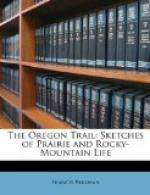After having ridden in this manner for six or eight miles, the appearance of the scene began to change, and all the declivities around us were covered with forests of tall, slender pine trees. The Indians began to fall off to the right and left, and dispersed with their hatchets and knives among these woods, to cut the poles which they had come to seek. Soon I was left almost alone; but in the deep stillness of those lonely mountains, the stroke of hatchets and the sound of voices might be heard from far and near.
Reynal, who imitated the Indians in their habits as well as the worst features of their character, had killed buffalo enough to make a lodge for himself and his squaw, and now he was eager to get the poles necessary to complete it. He asked me to let Raymond go with him and assist in the work. I assented, and the two men immediately entered the thickest part of the wood. Having left my horse in Raymond’s keeping, I began to climb the mountain. I was weak and weary and made slow progress, often pausing to rest, but after an hour had elapsed, I gained a height, whence the little valley out of which I had climbed seemed like a deep, dark gulf, though the inaccessible peak of the mountain was still towering to a much greater distance above. Objects familiar from childhood surrounded me; crags and rocks, a black and sullen brook that gurgled with a hollow voice deep among the crevices, a wood of mossy distorted trees and prostrate trunks flung down by age and storms, scattered among the rocks, or damming the foaming waters of the little brook. The objects were the same, yet they were thrown into a wilder and more startling scene, for the black crags and the savage trees assumed a grim and threatening aspect, and close across the valley the opposing mountain confronted me, rising from the gulf for thousands of feet, with its bare pinnacles and its ragged covering of pines. Yet the scene was not without its milder features. As I ascended, I found frequent little grassy terraces, and there was one of these close at hand, across which the brook was stealing, beneath the shade of scattered trees that seemed artificially planted. Here I made a welcome discovery, no other than a bed of strawberries, with their white flowers and their red fruit, close nestled among the grass by the side of the brook, and I sat down by them, hailing them as old acquaintances; for among those lonely and perilous mountains they awakened delicious associations of the gardens and peaceful homes of far-distant New England.




